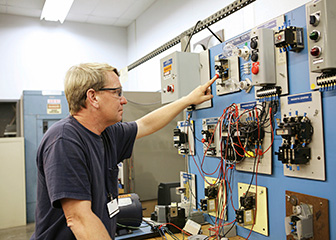Summary
Please enable javascript to play this video.
| Quick Facts: Electrical and Electronics Installers and Repairers | |
|---|---|
|
$71,270 per year
$34.26 per hour |
|
| See How to Become One | |
| See How to Become One | |
| See How to Become One | |
| 118,800 | |
| 0% (Little or no change) | |
| 400 | |
What Electrical and Electronics Installers and Repairers Do
Electrical and electronics installers and repairers install or repair a variety of electrical equipment.
Work Environment
Many electrical and electronics installers and repairers work in repair shops or in factories. Installers and repairers may have to lift heavy equipment and work in awkward positions. The majority work full time.
How to Become an Electrical or Electronics Installer and Repairer
Electrical and electronics installers and repairers need at least a high school education, but most specializations require further preparation through advanced education, apprenticeship training, or work experience.
Pay
The median annual wage for electrical and electronics installers and repairers was $71,270 in May 2024.
Job Outlook
Overall employment of electrical and electronics installers and repairers is projected to show little or no change from 2024 to 2034.
Despite limited employment growth, about 9,600 openings for electrical and electronics installers and repairers are projected each year, on average, over the decade. Most of those openings are expected to result from the need to replace workers who transfer to different occupations or exit the labor force, such as to retire.
State & Area Data
Explore resources for employment and wages by state and area for electrical and electronics installers and repairers.
Similar Occupations
Compare the job duties, education, job growth, and pay of electrical and electronics installers and repairers with similar occupations.
More Information, Including Links to O*NET
Learn more about electrical and electronics installers and repairers by visiting additional resources, including O*NET, a source on key characteristics of workers and occupations.
 United States Department of Labor
United States Department of Labor










